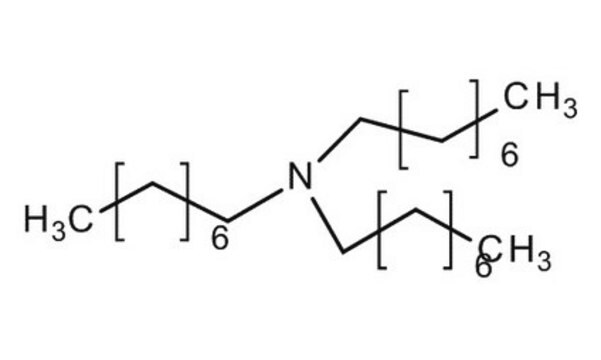Key Documents
O7805
Oleylamine
technical grade, 70%
Synonim(y):
cis-1-Amino-9-octadecene, cis-1-Amino-9-octadecene
About This Item
Polecane produkty
klasa czystości
technical grade
ciśnienie pary
8 mmHg ( 135 °C)
Próba
70%
skład
primary amine, >98%
współczynnik refrakcji
n20/D 1.4596 (lit.)
tw
348-350 °C (lit.)
mp
18-26 °C (lit.)
gęstość
0.813 g/mL at 25 °C (lit.)
ciąg SMILES
[H]\C(CCCCCCCC)=C(/[H])CCCCCCCCN
InChI
1S/C18H37N/c1-2-3-4-5-6-7-8-9-10-11-12-13-14-15-16-17-18-19/h9-10H,2-8,11-19H2,1H3/b10-9-
Klucz InChI
QGLWBTPVKHMVHM-KTKRTIGZSA-N
Szukasz podobnych produktów? Odwiedź Przewodnik dotyczący porównywania produktów
Opis ogólny
Zastosowanie
Hasło ostrzegawcze
Danger
Zwroty wskazujące rodzaj zagrożenia
Zwroty wskazujące środki ostrożności
Klasyfikacja zagrożeń
Acute Tox. 4 Oral - Aquatic Acute 1 - Aquatic Chronic 1 - Asp. Tox. 1 - Eye Dam. 1 - Skin Corr. 1B - STOT RE 2 - STOT SE 3
Organy docelowe
Respiratory system
Kod klasy składowania
8A - Combustible corrosive hazardous materials
Klasa zagrożenia wodnego (WGK)
WGK 3
Temperatura zapłonu (°F)
309.2 °F - closed cup
Temperatura zapłonu (°C)
154 °C - closed cup
Środki ochrony indywidualnej
Eyeshields, Faceshields, Gloves, type P3 (EN 143) respirator cartridges
Wybierz jedną z najnowszych wersji:
Masz już ten produkt?
Dokumenty związane z niedawno zakupionymi produktami zostały zamieszczone w Bibliotece dokumentów.
Klienci oglądali również te produkty
Produkty
Solwotermalna synteza nanocząstek: zastosowania od nanoobwodów i obwodów nanooptycznych do nanomagnetyki i biotechnologii.
Solvothermal synthesis is a method for preparing a variety of materials such as metals, semiconductors, ceramics, and polymers.
Professor Randal Lee (University of Houston, USA) discusses design considerations for iron oxide magnetic nanospheres and nanocubes used for biosensing, including synthetic procedures, size, and shape. The effects of these variables are discussed for various volumetric-based and surface-based detection schemes.
Nasz zespół naukowców ma doświadczenie we wszystkich obszarach badań, w tym w naukach przyrodniczych, materiałoznawstwie, syntezie chemicznej, chromatografii, analityce i wielu innych dziedzinach.
Skontaktuj się z zespołem ds. pomocy technicznej















